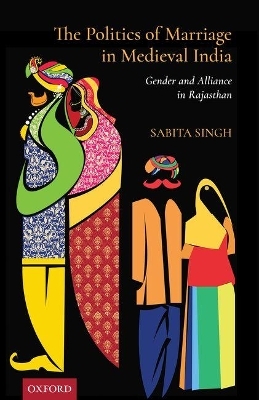
The Politics of Marriage in Medieval India
Gender and Alliance in Rajasthan
Seiten
2019
OUP India (Verlag)
978-0-19-949145-2 (ISBN)
OUP India (Verlag)
978-0-19-949145-2 (ISBN)
Through the study of the various aspects of marriage, this book highlights the cultural diversity of India. An account has been given of the changing political and social structure of the entire medieval period and how that affected the cultural sub-structure, which is observed through the prism of the institution of marriage in Rajasthan.
Marriage customs and rituals have been situated in the changing social and political structure and a study has been made of polygamy, dowry, concubinage, and the age of marriage. The shifting motivations for marriage alliances in that period, be they political or economic, have also been analysed.
Two prominent themes in this book are Sati and widowhood, which are seen as forms of women's oppression. The conventional narrative behind these practices are challenged, and the complex motives behind committing Sati are appraised. Widow remarriage was prevalent, not only among all castes but even among the upper caste Rajputs, so it was not the lack of widow remarriage that compelled the women to become Sati.
The book touches on martial and sexual morality of the time. This includes recording instances of infidelity and the State response thereof. The book approaches this topic from a historical perspective, based on archival and literary evidence.
Marriage customs and rituals have been situated in the changing social and political structure and a study has been made of polygamy, dowry, concubinage, and the age of marriage. The shifting motivations for marriage alliances in that period, be they political or economic, have also been analysed.
Two prominent themes in this book are Sati and widowhood, which are seen as forms of women's oppression. The conventional narrative behind these practices are challenged, and the complex motives behind committing Sati are appraised. Widow remarriage was prevalent, not only among all castes but even among the upper caste Rajputs, so it was not the lack of widow remarriage that compelled the women to become Sati.
The book touches on martial and sexual morality of the time. This includes recording instances of infidelity and the State response thereof. The book approaches this topic from a historical perspective, based on archival and literary evidence.
Sabita Singh teaches history at Deshbandhu College, University of Delhi.
Acknowledgements
Abbreviations
Introduction
Chapter I Political and Social Structure of Medieval Rajastan
Chapter II Socio-Political and Economic Aspects of Marriage
Chapter III Interpretation of Marriage Rituals in Medieval Rajastan
Chapter IV Sati, Widowhood, and Remarriage
Chapter V Marital Morality in Medieval Rajasthan
Conclusion
Bibliography
Index
About the Author
| Erscheinungsdatum | 25.07.2019 |
|---|---|
| Verlagsort | New Delhi |
| Sprache | englisch |
| Maße | 145 x 215 mm |
| Gewicht | 462 g |
| Themenwelt | Geisteswissenschaften ► Geschichte ► Regional- / Ländergeschichte |
| Geschichte ► Teilgebiete der Geschichte ► Kulturgeschichte | |
| Sozialwissenschaften ► Soziologie ► Gender Studies | |
| Sozialwissenschaften ► Soziologie ► Mikrosoziologie | |
| ISBN-10 | 0-19-949145-3 / 0199491453 |
| ISBN-13 | 978-0-19-949145-2 / 9780199491452 |
| Zustand | Neuware |
| Haben Sie eine Frage zum Produkt? |
Mehr entdecken
aus dem Bereich
aus dem Bereich
der stille Abschied vom bäuerlichen Leben in Deutschland
Buch | Hardcover (2023)
C.H.Beck (Verlag)
23,00 €
vom Mittelalter bis zur Gegenwart
Buch | Softcover (2024)
C.H.Beck (Verlag)
12,00 €


